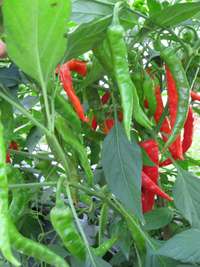
Figure 9. ‘Asia Cayenne’ plant with green and red peppers. Source: Holly Sobetski.
Capsicum annuum includes many varieties of chili and sweet peppers, with wide diversity in fruit size, shape, color, and flavor. Cayenne peppers are typically long and thin in shape. As a chili type, most cayenne varieties are pungent. Pungency is what gives hot peppers their spicy flavor. Cayenne peppers can be hotter than jalapeños. Not all cayenne varieties, however, are pungent. ECHO’s global seed bank offers ‘Asia Cayenne’, which produces an abundance of long, narrow, bright-red peppers (Figure 9) without the pungency of other chili peppers.
Peppers are grown in many parts of the tropics and sub-tropics, with top-producing countries including India, Sri-Lanka, Ghana, Nigeria, and Mexico (Olatunji and Afolayan, 2018). Ideal growing temperatures are between 18 and 30°C (Grubben and El Tahir, 2004). Night temperatures above 32°C can adversely affect flowers, reducing fruit yield. At ECHO, in southwest Florida, Capsicum annuum varieties grow best when planted in the fall (at the end of the hot, rainy season), allowing plants to flower and fruit during the cooler and drier winter months (Sobetski, 2022).
Sow pepper seeds in a nursery bed or trays protected from rain and direct sun. Transplant pepper seedlings 4 to 6 weeks after seeding, when seedlings have 8 to 10 leaves (Grubben and El Tahir, 2004). Here are some tips to maximize survival of seedlings:
- To protect nursery seedlings from rain and direct sun, shelter beds or trays with materials like straw or palm branches.
- A week before transplanting, reduce watering and shade to acclimate seedlings to dryer soil and more sun. This practice, called hardening, prepares seedlings for growing conditions in the garden or field.
- Minimize wilting of newly transplanted seedlings by transplanting late in the day when the sun is less intense, keeping some of the original soil with the roots when transplanting, and watering right after transplanting.
Grubben and El Tahir (2004) suggest a plant spacing of 20-40 cm (in-row) X 50-80 cm (between-rows). Their online Plant Resources of Tropical Africa (PROTA) content includes details on other aspects of growing the crop like weeding, watering, fertility inputs, and pest management.
‘Asia Cayenne’ peppers turn from green to red as they mature. Once the peppers have reached full size, you can harvest and eat them at both the green and red stages. Harvest by hand or with a small knife. Pick the fruit regularly to prolong production. ‘Asia Cayenne’ peppers can be eaten fresh and are excellent in salads. You can also cook them and incorporate them into other foods. They are a good source of vitamins (e.g., A and C) and minerals (e.g., calcium and potassium).
‘Asia Cayenne’ is an open-pollinated variety; stability of traits over successive generations of seed saving 7 is higher with open-pollinated than hybrid varieties. There is some variation in this variety, so if you notice any plants that have fruit with pungency or that are uncharacteristic with traits you don’t like, remove those plants as early as possible before collecting seeds (Sobetski, 2022).
Active development workers who are members on ECHOcommunity.org may request a trial packet of this or other seed. (See the website for how to register as a member and how to order seeds.)
References
Colley, M., J. Zystro, L. Buttala, and S. Siegel. 2015. The Seed Garden: The Art and Practice of Seed Saving. Seed Savers Exchange.
Grubben, G.J.H. and I.M. El Tahir. 2004. Capsicum annuum L. [Internet] Record from PROTA4U. Grubben, G.J.H and Denton, O.A. (Editors). PROTA (Plant Resources of Tropical Africa). Accessed 6 September 2022.
Olatunji, T.L. and A. J. Afolayan. 2018. The suitability of chili pepper (Capsicum annuum L.) for alleviating human micronutrient dietary deficiencies: A review. Food Science and Nutrition 6(8):2239-2251.
Sobetski, H. 2022. Personal communication.